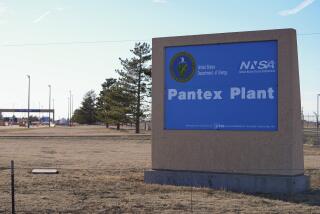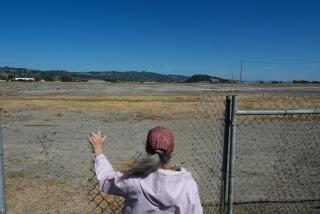Energy Department probes radioactive leak at New Mexico nuclear dump
The U.S. Energy Department said Tuesday it had opened an investigation into a leak of radioactive materials at a nuclear burial site near Carlsbad, N.M.
The department shut down normal operations last week at its Waste Isolation Pilot Plant after radiation alarms sounded late Friday, when no one was in the underground facility.
Officials at the site discounted any effect on human health, saying no radiation had escaped to the surface and no workers were exposed. So far, it is unknown what caused the release of radioactivity inside the repository, built in ancient salt beds 2,150 feet below the surface.
The shutdown could have an impact on the nation’s massive nuclear weapons cleanup program, which sends a couple of truckloads of waste to the facility almost every day.
The waste isolation plant takes clothes, tools, wood, paper and other items contaminated at low levels with plutonium and other human-made elements heavier than uranium.
Energy Department officials said their primary focus was on the health and safety of the public, workers and the environment.
“DOE is establishing an investigation team for the Feb. 14 event at WIPP and is working on developing a plan to safely reenter the WIPP underground facility,” a department statement said. “At this time there is no immediate impact on other cleanup sites.”
Operators of a nuclear cleanup project in Idaho, which sends the largest amount of waste to the Carlsbad dump, said Monday they were continuing normal operations but storing waste onsite until operations resumed at the New Mexico facility.
James Conca, a former official at the Carlsbad site who also worked at the Yucca Mountain location where a nuclear dump is proposed, defended the New Mexico site’s performance in the accident.
“WIPP worked exactly as we designed it, and this event (the first ever in WIPP’s 15-year history) showed this very well,” Conca said in an email to The Times. “Since it is the first event in a perfect operational history, it will be studied quite a bit more than would be warranted otherwise. It certainly is not a mess.”
Conca was responding to scientists who said that if the contamination was widespread inside the underground facility, the cleanup could be involved and expensive.
Conca has argued that the kind of ancient salt formations that underlie the Carlsbad site, and which also lies beneath much of the U.S., can provide a quick, safe and cost-effective solution for burying high-level radioactive waste, including spent nuclear reactor fuel and processed nuclear bomb waste. Efforts to build such a large-scale high-level repository have floundered for the last 30 years.
ALSO:
Official who raised safety concerns at Hanford nuclear site is fired
Soldier convicted in rape and murder of 14-year-old Iraqi girl is found hanged in prison
North Carolina regulators order Duke Energy to contain 2nd leak
More to Read
Sign up for Essential California
The most important California stories and recommendations in your inbox every morning.
You may occasionally receive promotional content from the Los Angeles Times.











